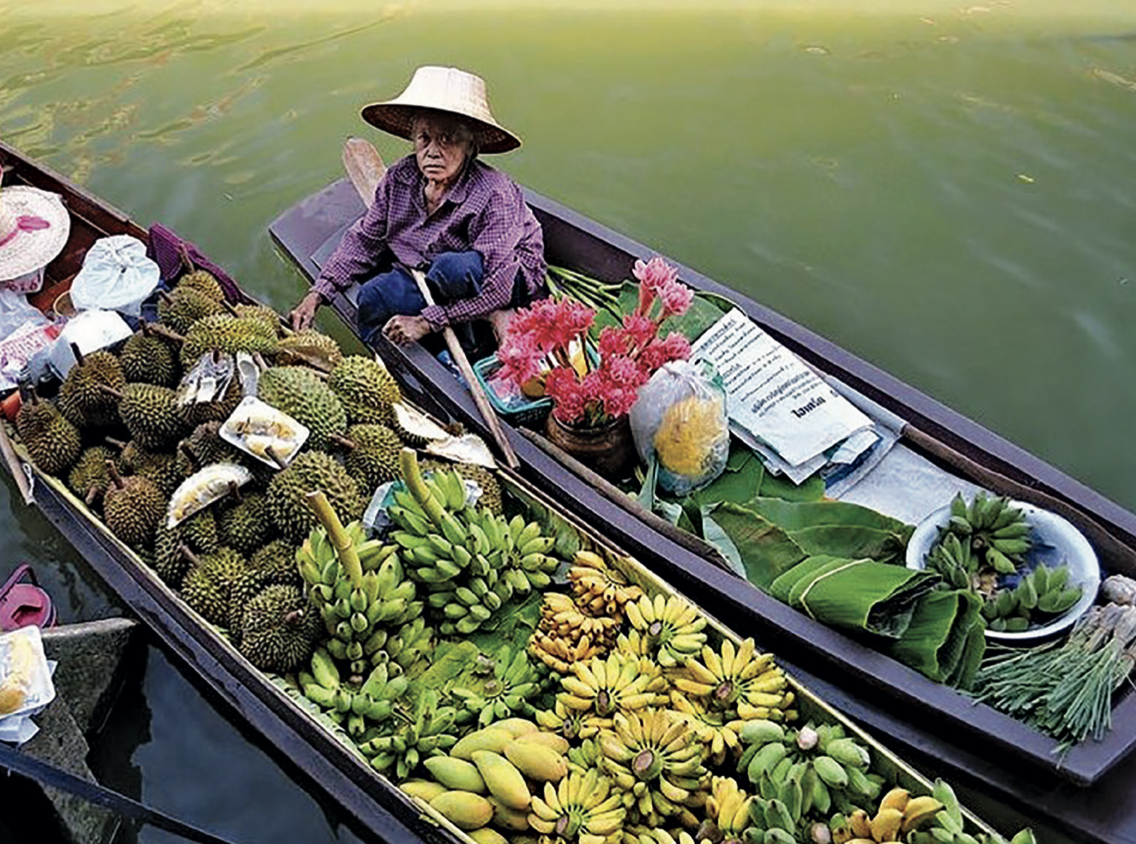By Ariane Arpin-Delorme
Experience the flavours of other lands at these famous markets that are worth the trip—even if that trip takes you to the other side of the world
Who doesn’t like strolling through a local market, discovering new foods and getting a feel for a community? Tourist attractions unto themselves, markets can be an integral part of an authentic experience, letting visitors move to the beat of the people who make these gathering places hum.
Guernica Market
It is in the coastal region between Bilbao and San Sebastian on the Bay of Biscay, in Spain’s Basque Country, that you’ll find the highest concentration of top chefs per capita. The historic city of Guernica is home to the largest market in the Biscay region: a place dotted with artisanal cheese makers, bakers, cider producers, and fishmongers, where traditions endure for generations. Walk around and grab some pintxos (Basque tapas) or pil pil (salted) cod paired with txakoli, a white wine unique to the region.
Pro tip: Time your visit to catch the Guernica food fair on the last Monday of October every year, when more than 900 booths fill the streets.
Key Afer Market
The tribal market in the small town of Key Afer in Ethiopia is held weekly and brings together people from the Tsemai, Hamer, and Bena tribes. In addition to fruits, vegetables and animals, you’ll find medicinal plants as well as materials for witchcraft. Discover the traditional large crepe called injera, a local specialty that is eaten with dishes served with a sauce, such as wat, a kind of stew, kefto (also called kitfo), a variation on the theme of beef tartare, or yetsom beyaynetu, a combination platter of local curries.
Pro tip: The Ethiopian coffee ceremony is about much more than sipping a tasty beverage. Take the time to experience this highly symbolic cultural and sensory ritual, preferably with your family.
Jemaa el-Fna Square
Savour street food among the aromas wafting from the pyramids of spices at the famous Jemaa el-Fna Square in Marrakesh (Morocco), a UNESCO-protected site. You can engage in friendly conversations with merchants and restaurateurs seated behind their massive stalls featuring dried fruit, pastillas (traditional meat pies made with chicken or pigeon), tajine, or couscous. It’s quite the spectacle to see vendors singing or shouting to sell their merchandise.
Pro tip: Watch out for imitations and substitutes: cheap powdered saffron is often stretched with turmeric, salt, and paprika. Be sure to haggle and, above all, take time to drink some tea, a key part of the tradition.
Amphawa Floating Market
In Amphawa, Thailand, you’ll find a real floating market selling textiles, flowers, exotic fruits, and useful household items. It is held only from Friday at noon to Saturday, and it’s fun to discover at night as the fireflies put on a light show. Sailing in a boat along the canals, you can order fried noodles, a skewer of grilled squid, and many other tasty foods.
Pro tip: Don’t confuse Amphawa’s market with the Damnoen Saduak floating market in Nakhon Pathom, west of Bangkok, which has become a real tourist trap.
George Town Markets
Penang, in Malaysia, with its old city, George Town, is one of the gastronomy capitals to explore at least once in your life. Protected by UNESCO, this city includes a wide range of neighbourhood markets with a cosmopolitan perspective. Your senses will be constantly stimulated: you’ll find vendors selling chestnuts and grilled corn and oyster omelettes alongside those selling samosas, silk saris, and jasmine wreaths.
Pro tip: Try char kway teow, a dish of rice noodles sautéed with chives, eggs, crispy bean sprouts, and shrimp, served to you in your rickshaw.
Carmel Market
Israel teems with markets where enormous amounts of delicacies are piled: sweets, meats, hummus and tahini, pastries, and almost anything you can think of. The Carmel Market is the city’s largest and most visited. In the land of orange trees, enjoy huge fruits amid a cacophony of sound, heat, and the aroma of fresh falafels or local breakfast dishes, such as Egyptian ful (fava bean stew) or Tunisian chakchouka (eggs in tomato sauce).
Pro tip: The end of the day can be a good time to visit the market, as sellers often offer unbeatable prices on their products. On Fridays, a busy day for shopping for provisions, the market closes two hours before nightfall for the Sabbath.
Suva Market
One of the best ways to start a day is, without a doubt, a stroll at dawn through the Suva market on the island of Viti Levu, in Fiji. Let yourself be guided by the aroma of spices and fresh herbs, and learn how to use Fiji’s lush environment to make natural dyes, medicines, and fine fragrances.
Pro tip: Some hotels offer the kava ceremony, at which you can try this relaxing drink made from a root, as well as lovo, a traditional Indo-Fijian meat-and-vegetable dish wrapped in palm leaves and cooked underground.
Margaret River Farmers’ Market
A small coastal town south of Perth in Western Australia, Margaret River is famous for surfing, craft breweries, and wine. The stalls of the Margaret River Farmers’ Market (open every Saturday morning year-round) feature local producers only—no resellers. On the third Sunday morning of each month, you can discover the region’s wineries, which produce an almost indecent proportion of Australia’s best Chardonnays and Cabernets. After chatting with the producers, you can end the day with a hearty Australian barbecue (“barbie”) on the beach, your bag filled with provisions.
Pro tip: Visit the stalls that sell Indigenous plants used in traditional cuisine, which you can prepare in the local style!
Otavalo and Saquisili Markets
North of the capital, Quito, in Equador, is the small city of Otavalo, known for its Saturday market. Jewellery, jade, wooden sculptures, handwoven woollen clothing, and handmade melcocha candy are available if you’re looking for one-of-a-kind souvenirs. If you’re an early riser, you can take in the Thursday livestock market in Saquisili, the most typical one in the country. While you’re there, have a gigantic meal-sized soup for lunch.
Pro tip: Sold in large quantities at the market, zampoñas, or pan pipes, are made in San Miguel de Ibarra. It’s not far from Otavalo, so plan a visit if you’re interested in learning how they’re made.
Photo: Ariane Arpin-Delorme






